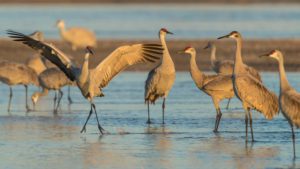I was visiting Grand Island, Nebraska for work earlier this month, which happened to be the beginning of the spring sandhill crane migration. Every year 400,000 to 600,000 sandhill cranes – 80% of all the cranes on the planet, by the way – congregate along an 80-mile stretch of the central Platte River in Nebraska. During their stay, they fatten up on waste grain in the empty cornfields to prepare for the journey to their nesting grounds in the Arctic and sub-Arctic. These cranes live to be around 35 years of age and travel twice a year. In the spring, they travel north. In the fall they travel back down south to Texas and Mexico. This was the second time I was able to see this incredible sight of this enormous mass of birds doing what comes, well, naturally.
The sandhill crane flies approximately 4,000 miles twice a year in its migration pattern. They are searching for habitats that can provide them with the nutrients and resources they need to thrive – but they don’t do it all at once! For the cranes, they stay in Nebraska for 2-3 weeks gaining 5-15% of their body weight and stockpiling the resources they will need to take for the next 400 + miles of their journey. For the cranes, how the migration journey is designed is as important as getting to their destination.
I was sitting in the blind, watching the cranes flying in to roost on the Platte River after a day of foraging, and I started thinking about what migrations might teach us about leading change in our organizations. We often talk about reframing organizations as a forced march to a destination. Obviously, this change design doesn’t allow for stops or detours along the way. That would mean we are off course, and might not make our deadline. What if we tried to change this mindset? What could the cranes, and Nature, teach us about change management?
Lessons on change from nature’s migrations
There are a number of lessons we could apply to our organizational change efforts from the migrating sandhill cranes.
- There are stops along the way to stock up and generate energy for the next phase of the journey. If we looked at organizational change through the lens of migrations, we might see change as a journey with stops along the way. In migrations, pauses to feed and increase weight have a purpose, to maintain energy for a long journey. In organizations, if we don’t acknowledge and adjust for the energy our staff has to engage in change we may get to our destination completely depleted. If our staff become depleted, they don’t have the resources to maintain and sustain change.
- They celebrate along the way. Cranes are known for dancing as part of their courtship rituals. I noticed that they also celebrate after landing in their temporary roosts. After a day’s foraging, they fly across the evening sky in waves, and once they landed, there would be what looked like a celebratory dance before they settled. If celebration does occur in human organizations, it is at the end of a change effort, not along the way. Change requires positive human energy to be successful. Celebrating along the way can sustain this energy for the journey to the destination.
In my experience, human organizations don’t celebrate enough.
- Cranes swarm as they fly in for a landing after days of foraging. The sandhill crane’s wingspan can be up to five and a half feet wide, so these are not small birds. And yet, they don’t run into each other or land on top of each other. Rather, they are elegant to watch as they change direction, without a leader telling them what to do. We know from research that birds displaying this swarming behavior fly in the same direction, at the same speed, and in close proximity. What would happen if we designed our change efforts in a way to generate a human swarm? This would mean that everyone has a shared understanding of the destination (purpose) behind the change. We would pace change so we can fly at a similar speed and create ways for people to connect and be in proximity to each other as we engage in the change work.
There are other lessons we can learn from migration patterns of behavior, but I thought we could begin with these three lessons to ponder as spring migrations are happening all around us.
What lessons have you learned in your organizations that reflect migrating change?







Sandhill crane behaviors of making stops along the way, celebrations, and group swarming are interesting concepts that illustrate important phases of organizational and personal renewal. Thanks Dr. Allen